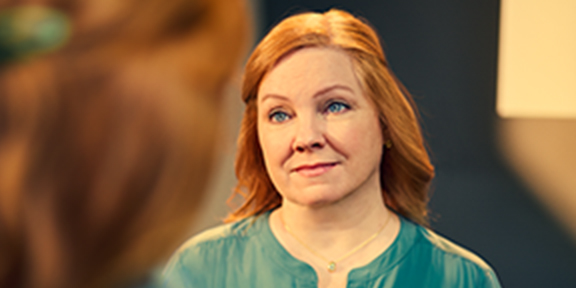For Healthcare Professionals
The information contained in this website is technical in nature and intended only for healthcare professionals in the United States. If you are a US healthcare professional, select the “Yes” button below.
I am a US healthcare professional and would like to continue.

The truth about clinical trials: presenting the facts for healthcare providers
Dispelling common perceptions about clinical trials
Misunderstandings about clinical trials make patients less confident in them. By addressing these misunderstandings, we aim to equip you with the knowledge to confidently discuss trial participation with your patients, ensuring that they understand the opportunities available. Whether you’re considering a trial for a newly diagnosed patient or exploring innovative therapies for someone who hasn’t found success with standard treatments, the facts presented here will help guide your decision-making and patient conversations.

Oncology clinical trial perceptions vs reality
Is the message below a perception or reality?
Select each card to reveal the answer.
Perception: Clinical trials are only for patients who have exhausted all treatment options.
Reality:
Clinical trials are available for patients across stages of their cancer journey, including newly diagnosed patients, those receiving treatment, or those in remission. Clinical trials have advanced over the years to offer cutting-edge treatments as first-line therapies or adjuvant therapies for many different tumor types.1
Perception: Placebos are commonly used in oncology trials, and patients may receive no treatment.
Reality:
Most phase III clinical trials compare new treatments with the current standard of care, so patients receive either the new treatment or the current standard of care.2
Perception: Only large academic medical centers have access to clinical trials.
Reality:
The landscape of clinical research has evolved. Today, phase III clinical trials are increasingly accessible through community hospitals. Advances in research infrastructure, along with collaborations between academic centers and local healthcare facilities, have expanded access to cutting-edge treatments. Patients no longer need to travel to major academic centers to participate in these critical trials.2
Perception: Clinical trials are too complicated and time-consuming for patients and physicians.
Reality:
Research coordinators, trial navigators, and other resources are available to ensure that treatment can begin as soon as possible.
Perception: Clinical trials are too costly and often aren’t covered by insurance.
Reality:
Most health insurance plans, including Medicare, cover the routine costs of care in a clinical trial.
Lilly and other trial sponsors may reduce financial burden by paying for protocol-required medicines and procedures, including medications, labs/testing, and travel and accommodation for the patient and a caregiver.3
Perception: Clinical trial participation can limit future treatment options.
Reality:
Participation in a clinical trial does not always limit future treatment options. Patients can often return to standard treatment, if necessary, after participating in a trial.4
Perception: Clinical trials are only for patients who have exhausted all treatment options.
Reality:
Clinical trials are available for patients across stages of their cancer journey, including newly diagnosed patients, those receiving treatment, or those in remission. Clinical trials have advanced over the years to offer cutting-edge treatments as first-line therapies or adjuvant therapies for many different tumor types.1
Perception: Placebos are commonly used in oncology trials, and patients may receive no treatment.
Reality:
Most phase III clinical trials compare new treatments with the current standard of care, so patients receive either the new treatment or the current standard of care.2
Perception: Only large academic medical centers have access to clinical trials.
Reality:
The landscape of clinical research has evolved. Today, phase III clinical trials are increasingly accessible through community hospitals. Advances in research infrastructure, along with collaborations between academic centers and local healthcare facilities, have expanded access to cutting-edge treatments. Patients no longer need to travel to major academic centers to participate in these critical trials.2
Perception: Clinical trials are too complicated and time-consuming for patients and physicians.
Reality:
Research coordinators, trial navigators, and other resources are available to ensure that treatment can begin as soon as possible.
Perception: Clinical trials are too costly and often aren’t covered by insurance.
Reality:
Most health insurance plans, including Medicare, cover the routine costs of care in a clinical trial.
Lilly and other trial sponsors may reduce financial burden by paying for protocol-required medicines and procedures, including medications, labs/testing, and travel and accommodation for the patient and a caregiver.3
Perception: Clinical trial participation can limit future treatment options.
Reality:
Participation in a clinical trial does not always limit future treatment options. Patients can often return to standard treatment, if necessary, after participating in a trial.4
Perception: Clinical trials are only for patients who have exhausted all treatment options.
Reality:
Clinical trials are available for patients across stages of their cancer journey, including newly diagnosed patients, those receiving treatment, or those in remission. Clinical trials have advanced over the years to offer cutting-edge treatments as first-line therapies or adjuvant therapies for many different tumor types.1
Perception: Placebos are commonly used in oncology trials, and patients may receive no treatment.
Reality:
Most phase III clinical trials compare new treatments with the current standard of care, so patients receive either the new treatment or the current standard of care.2
Perception: Only large academic medical centers have access to clinical trials.
Reality:
The landscape of clinical research has evolved. Today, phase III clinical trials are increasingly accessible through community hospitals. Advances in research infrastructure, along with collaborations between academic centers and local healthcare facilities, have expanded access to cutting-edge treatments. Patients no longer need to travel to major academic centers to participate in these critical trials.2
Perception: Clinical trials are too complicated and time-consuming for patients and physicians.
Reality:
Research coordinators, trial navigators, and other resources are available to ensure that treatment can begin as soon as possible.
Perception: Clinical trials are too costly and often aren’t covered by insurance.
Reality:
Most health insurance plans, including Medicare, cover the routine costs of care in a clinical trial.
Lilly and other trial sponsors may reduce financial burden by paying for protocol-required medicines and procedures, including medications, labs/testing, and travel and accommodation for the patient and a caregiver.3
Perception: Clinical trial participation can limit future treatment options.
Reality:
Participation in a clinical trial does not always limit future treatment options. Patients can often return to standard treatment, if necessary, after participating in a trial.4
*Survey from Memorial Sloan Kettering Cancer Center. OncLive 2016.5
References
- Leukemia & Lymphoma Society. Clinical trials. Accessed November 14, 2024. https://www.lls.org/treatment/types-treatment/clinical-trials
- American Cancer Society. Types and phases of clinical trials. Updated August 18, 2020. Accessed November 14, 2024. https://www.cancer.org/cancer/managing-cancer/making-treatment-decisions/clinical-trials/what-you-need-to-know/phases-of-clinical-trials.html
- Williams CP, Fleury ME, Qasim Hussaini SM. Could financial reimbursement increase clinical trial inclusivity? ASCO Daily News. July 24, 2024. Accessed November 14, 2024. https://dailynews.ascopubs.org/do/could-financial-reimbursement-increase-clinical-trial-inclusivity
- Carter D. Clinical trials: 5 things you should know. University of Texas MD Anderson Cancer Center. Published October 13, 2020. Accessed November 14, 2024. https://www.mdanderson.org/cancerwise/cancer-clinical-trials-phases.h00-159385890.html
- Memorial Sloan Kettering Cancer Center. Despite pressing need, survey finds most Americans unlikely to enroll in clinical trials. Published May 23, 2016. Accessed January 21, 2025. https://www.mskcc.org/news-releases/despite-pressing-need-survey-finds-most-americans-unlikely-enroll-clinical-trials








